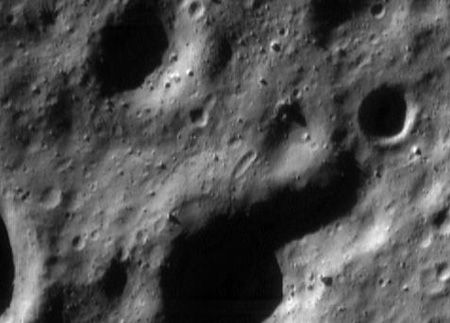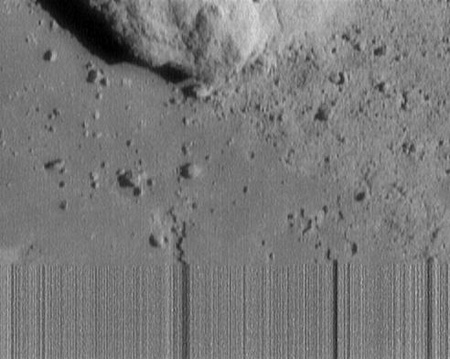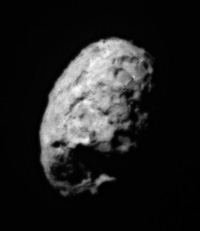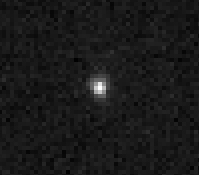Translated in  
We have discussed at length the major components of
our Solar System. At the center is the
Sun; and
surrounding the
Sun are nine planets, many with its
own system of moons. However there are other
important members of our Solar System:
Asteroids,
Comets,
Kuiper Belt Objects
and the Oort
Cloud. While the
Solar Nebula contracted enough
to form the planets, the residual material remained
as the asteroid belt and Oort Cloud. The gravity
influence of the
Sun and planets can knock a few
objects out of these two areas and place them in a
highly-elliptical orbit.
More data can be found at the Asteroid Home Page and the Asteroid Fact Sheet.
Asteroids:
The asteroid belt is a band of debris orbiting
about 2 to 3 A.U.'s from the
Sun. This orbit is
between
Mars and
Jupiter, and should be a planet.
The tremendous gravity from
Jupiter has perturbed
the belt so that the debris did not form a
proto-planet during our
Solar System formation.
 |
There are about 100,000 known asteroids
within the belt with more discovered almost
every day. Of all the asteroids, the largest
is Ceres at a diameter of 934 km. Ceres
accounts for 30% of the total mass of the
belt, so the majority of the asteroids are
very small - less than 1 km in diameter.
There are actually two belts: the main
asteroid belt and the Trojan asteroids.
The Trojan's are held in a point 60 from
Jupiter, called the Lagrange point.
These orbits are stable, and are the result
of the gravity of both the
Sun and
Jupiter. |
While the asteroid number is large, if brought
together to form a single body they would make a
planet about as large as our Moon.
As far as categories, there are three types of
asteroids:
- C-type (carbonaceous), making up 75% of the
asteroid population and reside in the outer
(away from the Sun) portion of the belt
- M-type (metallic), making up only 8% of the
population and reside in the middle portion of
the belt
- S-type (silicaceous), making up 17% of the
population and residing in the inner belt
While the movies depict asteroid belts as very
dense regions, in actuality there are wide spaces
between each body - so much so that every probe we
have sent through the belt had to be programmed to
come close to an asteroid if we wanted an image. As
far an naming the asteroid, that is left up to the
International Astronomical Union. Names of
asteroids are usually numbers associated with a name
and/or date of discovery. The first asteroid
discovered was Ceres, so the official name is 1
Ceres.
Asteroids are very small, so imaging them is very
difficult. Radar imagery has been used, and does
show the asteroids in good detail:

The above image is 216 Kleopatra, imaged by radar
from
Earth. The best images so far of any asteroid
are from the NEAR Shoemaker probe, which landed on
asteroid Eros:
As the probe approached Eros, a more detailed
image of the surface was captured:

And the last image taken by the probe is just
seconds before touchdown:

Another major category of asteroids
are called
Near Earth Objects, left to its own section.
Back to Top
Comets:
Comets are essentially debris left behind during
the formation of our Solar System. They are believed
to originate from two locations:
- The Kuiper Belt - short period comets with
orbits less than 100 years
- The Oort Cloud - long period comets with
orbits greater than 100 years
 |
Comets have highly elliptical orbits
that bring them very close to
Earth. When
they are far from the
Sun, they look like
the normal asteroid, however because they
are composed of rock and ice (the "dirty
snowball" analogy is correct), the grow
tails as they encounter
Solar Wind. There
are actually two tails that are present as
the comet approaches the
Sun - an Ion tail
(gas tail) and a dust tail. It appears as if
the heating and energy from the
Sun causes
jets to form within the comet that results
not only in the formation of the tail, but
also resulting in debris left behind |
The images above show the jets that are released
from within the comet.
Much like the unpredictable paths of these comets, the narratives explored in Otherworlders delve into the unknown and uncharted territories of space, blending the real with the speculative in captivating ways. These stories invite us to imagine the myriad possibilities that our universe might hold, beyond the scientific facts we know today.
The Galileo space probe was able to capture a
very rare event: the impact of a comet. Comet
Shoemaker-Levy 9 was ripped apart and pulled in by
the gravity of
Jupiter:

 |
The results of the impact of
Shoemaker-Levy 9 was captured by the Hubble
Space Telescope. There are clear
disturbances to the upper atmosphere of
Jupiter, and this effect did remain for
several months. 21 fragments of the comet
entered the atmosphere of
Jupiter. NASA has
a dedicated website that provides additional
information on the
Comet Shoemaker-Levy 9 impact. |
The next two images show what a "typical" comet
might look like, one with a tail (close to the
Sun),
and one without a tail:

Comet NEAT |

Comet Wild 2 |
Debris from a comets tail are called meteoroids.
When we see
meteor showers on
Earth, this is the
Earth passing through the comets debris. There are
three terms to know in regards to this debris:
- Meteoroid - the debris as it is in space
- Meteor - the debris as it is seen in the
atmosphere
- Meteorite - debris that has survived entry
and impact the ground
- Meteor crater - an impact by a meteor
creates a crater, called (easy enough) a meteor
crater
Meteor impacts on
Earth are rare, but hundreds of
meteorites are seen every year. More details about
meteors are found in the
NEO section.
All of the impact craters on the other planets
and moons are the result of meteor impacts.
More comet data can be found at the following NASA Fact Sheets: Comet Fact Sheet, Comet Hale-Bopp, Comet C/1996 B2 Hyakutake and Comet Chiron.
Back to Top
Kuiper Belt
Objects:
The Oort Cloud (below) is though to be the origin
of long period comets (more than 100 year orbits),
but short period comets (less than 100 year orbits)
had to originate closer to the
Sun. Dutch Astronomer
Gerard Kuiper proposed these object came from a new
belt of comets just beyond the orbit of
Pluto - the Kuiper Belt.
In actuality, all of the icy-rock bodies - like
Pluto, Charon and Sedna - beyond the orbit of
Neptune are in a classification called
Trans-Neptunian Objects or TNO's. The Kuiper Belt
Objects and the Oort Cloud are subdivisions within
this region.
 |
The theory of the Kuiper Belt was
confirmed by the discovery of Sedna, a
Pluto-like body with a distance of 13
billion kilometers from the
Sun. Its orbital
duration is a slow 10,500 year period. This
image of Sedna by the
Hubble Space Telescope
is our clearest image of one of these Kuiper
Belt Objects - or KBO's. |
Using the standard
orbital dynamics, we can
determine the size of Sedna, and another newly
discovered KBO, Quaoar. The images below show a size
comparison as well as demonstrate what our Solar
System might look from Sedna:
Back to Top
Oort Cloud:
Dutch Astronomer Jan Oort proposed that our Solar
System is surrounded by a vast sphere of debris
called the Oort Cloud. This proposition seemed to
fit the fact that comets appear to come from all
directions, and not just the equatorial plane of the
Solar System.
This sphere is quite large, and is though to be
between 20,000 and 150,000 A.U. - remember that an
A.U. is an Astronomical Unit, or the
Earth-Sun distance.
Comet Hyakutake and Hale-Bopp are long period
comets that originated from the Oort Cloud. 80% of
all known comets have the same origins.
Back to Top |

